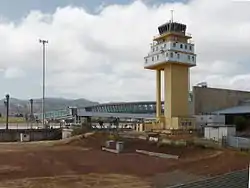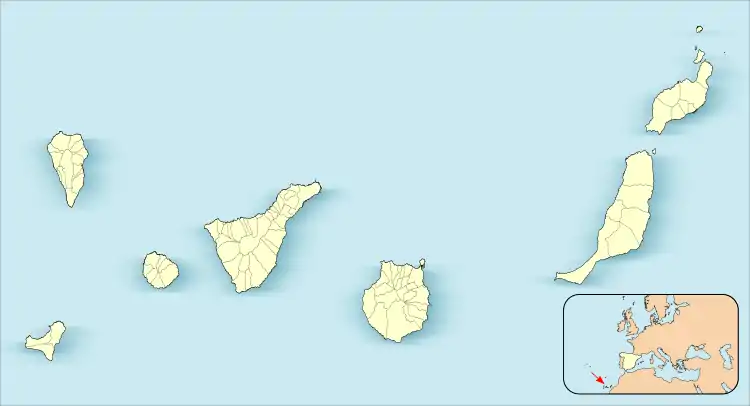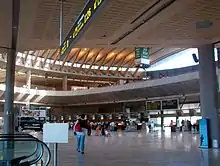Tenerife North Airport
Tenerife North–Ciudad de La Laguna Airport (IATA: TFN, ICAO: GCXO), formerly Los Rodeos Airport, is the smaller of the two international airports on the island of Tenerife, Spain. It is located in San Cristóbal de La Laguna, 11 km (6.8 mi) by road from Santa Cruz and at an altitude of 633 metres (2,077 ft). It handled 3,717,944 passengers in 2012. Combined with Tenerife South Airport, the island gathers the highest passenger movement of all the Canary Islands, with 12,248,673 passengers,[1] surpassing Gran Canaria Airport. Today TFN is an inter-island hub connecting all seven of the main Canary Islands with connections to the Iberian Peninsula and Europe.
Tenerife North-Ciudad de La Laguna Airport Aeropuerto de Tenerife Norte-Ciudad de La Laguna | |||||||||||||
|---|---|---|---|---|---|---|---|---|---|---|---|---|---|
 | |||||||||||||
 | |||||||||||||
| Summary | |||||||||||||
| Airport type | Public | ||||||||||||
| Owner | ENAIRE | ||||||||||||
| Operator | Aena | ||||||||||||
| Serves | Santa Cruz de Tenerife, Tenerife | ||||||||||||
| Location | San Cristóbal de La Laguna | ||||||||||||
| Elevation AMSL | 633 m / 2,077 ft | ||||||||||||
| Coordinates | 28°28′58″N 016°20′30″W | ||||||||||||
| Website | aena-aeropuertos.es | ||||||||||||
| Map | |||||||||||||
 TFN Location of airport in Canary Islands | |||||||||||||
| Runways | |||||||||||||
| |||||||||||||
| Statistics (2019) | |||||||||||||
| |||||||||||||
In 1977, the airport was the site of the worst accident in aviation history, when two Boeing 747s collided on the runway in heavy fog conditions, causing the deaths of 583 passengers and crew.
History
Early years
Many years before the airport had even been built, the field at Los Rodeos was hastily prepared to accommodate the first (though unofficial) flight into Tenerife operated by an Arado V I (D-1594) aircraft operating from Berlin on behalf of Deutsche Luft Hansa.
In May 1930, the Compañía de Líneas Aéreas Subvencionadas S.A. (C.L.A.S.S.A.) established the first air link between the Spanish mainland and the Canary Islands using a Ford 4-AT Trimotor (M-CKKA), which took off from Getafe, Madrid to the Los Rodeos field via Casablanca, Cape Juby and Gando in Gran Canaria.
After the final location of the airport had been decided, funds were gathered between 1935 and 1939 to build a small hangar and begin expanding the airstrip which would become Los Rodeos.
Operations into Los Rodeos recommenced on 23 January 1941 with a De Havilland DH89A Dragon Rapide operating an Iberia flight from Gando in Gran Canaria. By 1946, more hangars, a passenger terminal and an 800 m (2,625 ft) paved runway had been built, and the airport was officially opened to all national and international traffic. The runway was stretched at various times during the 1940s and 1950s, reaching a length of 2,400 m (7,874 ft) in 1953, by which time the airport was also equipped with runway edge lighting and an air-ground radio, enabling night operations.
Development since the 1960s
By 1964, runway 12/30 had been stretched to 3,000 m (9,843 ft) to accommodate the DC-8, new navigation aids were installed, and the apron was expanded to provide more parking spaces for aircraft. In 1971, with the prospect of the Boeing 747 flying into the airport, the runway was reinforced and an ILS (Instrument Landing System) was installed.
A new airport, Tenerife South Airport, was inaugurated on 6 November 1978, in response to the 1977 Tenerife airport disaster which resulted in the highest number of fatalities (excluding ground fatalities) of any single accident in aviation history. The south airport is situated at sea level to avert the occurrence of fog, one of the reasons for the crash.
On 25 April 1980, Dan-Air Flight 1008 Boeing 727 crashed near the airport, killing all 146 on board, in a controlled flight into terrain accident.
A new terminal was opened at Tenerife North Airport in 2002, comprising car park, motorway access ramps, and four-story terminal building, with 12 gates. The airport regained its international status when flights to Caracas began. An inter-island domestic area was opened in 2005.
Airlines and destinations
The following airlines operate regular scheduled and charter flights to and from Tenerife North:[2]
| Airlines | Destinations |
|---|---|
| Air Europa | Madrid, Málaga, Santiago de Compostela, Seville Seasonal: Asturias, Bilbao |
| Binter Canarias | Barcelona,[3] El Hierro, Fuerteventura, Funchal, Gran Canaria, Jerez de la Frontera,[3] La Gomera, Lanzarote, La Palma, Lisbon, Palma de Mallorca, Santander,[4] Vigo, Vitoria,[4] Zaragoza[5] Seasonal: Agadir, Marrakesh |
| Bulgaria Air | Seasonal charter: Sofia |
| CanaryFly | El Hierro, Fuerteventura, Gran Canaria, Lanzarote, La Palma |
| Iberia Express | Madrid |
| Iberia Regional | Seasonal: Alicante, Asturias, Santiago de Compostela, Valencia, Valladolid |
| Plus Ultra Líneas Aéreas | Caracas |
| Ryanair | Barcelona, Madrid Seasonal: Alicante[6] |
| Vueling | A Coruña, Alicante, Asturias, Barcelona, Bilbao, Granada, Lisbon, Málaga, Palma de Mallorca (Begins 27 March 2021), Porto (begins 30 March 2021),[7] Rome–Fiumicino, Santiago de Compostela, Seville, Valencia, Zaragoza |
Statistics
 |



| Passengers | Aircraft movements | Cargo (tonnes) | |
|---|---|---|---|
| 2000 | 2,411,100 | 48,902 | 22,462 |
| 2001 | 2,511,277 | 49,132 | 21,060 |
| 2002 | 2,486,227 | 48,785 | 21,148 |
| 2003 | 2,919,087 | 53,718 | 23,842 |
| 2004 | 3,368,988 | 56,592 | 23,647 |
| 2005 | 3,754,513 | 60,235 | 22,163 |
| 2006 | 4,025,601 | 65,297 | 23,193 |
| 2007 | 4,125,131 | 65,843 | 25,169 |
| 2008 | 4,236,615 | 67,800 | 20,781 |
| 2009 | 4,054,147 | 62,776 | 18,304 |
| 2010 | 4,051,155 | 61,607 | 15,918 |
| 2011 | 4,095,103 | 62,590 | 15,745 |
| 2012 | 3,717,944 | 55,789 | 14,778 |
| 2013 | 3,524,470 | 49,289 | 13,493 |
| 2014 | 3,633,030 | 52,694 | 13,991 |
| 2015 | 3,815,315 | 53,259 | 12,819 |
| 2016 | 4,219,633 | 55,669 | 12,426 |
| 2017 | 4,704,863 | 61,098 | 13,044 |
| 2018 | 5,492,324 | 73,236 | 12,689 |
| 2019 | 5,840,483 | 75,385 | 12,596 |
| Source: AENA[8] | |||
Accidents and incidents
Tenerife airport disaster
On 27 March 1977, Tenerife North Airport (then Tenerife Los Rodeos) was the scene of the deadliest accident in aviation history, which claimed the lives of 583 people. While attempting to take off, KLM Flight 4805, a Boeing 747-206B, collided with Pan Am Flight 1736, a Boeing 747-121, which was taxiing along the runway. All 248 passengers and crew on the KLM flight were killed, along with 335 occupants of the Pan Am flight; however, 61 of the passengers and crew on board the Pan Am survived. Neither of the two airliners was originally scheduled to land on Tenerife, as both flights were bound for Gran Canaria Airport but had been diverted to Los Rodeos as a result of a terrorist bombing at Gran Canaria.
Other incidents
| Date | Airline | Aircraft type | Registration | Flight number | People on board | Fatalities |
|---|---|---|---|---|---|---|
| 1956-09-29 | Aviaco | SNCASE Languedoc | EC-AKV | 38 | 0+1 | |
| 1964-07-03 | Ejército del Aire | Douglas DC-3 | 21 | 4 | ||
| 1965-05-05 | Iberia | Lockheed L-1049G | EC-AIN | 401 | 49 | 30 |
| 1965-12-07 | Spantax | Douglas DC-3 | EC-ARZ | 32 | 32 | |
| 1966-09-16 | Iberia | Douglas DC-3 | EC-ACX | IB-261 | 27 | 1 |
| 1970-01-05 | Iberia | Fokker F-27 Friendship 600 | EC-BOD | 49 | 0 | |
| 1972-12-03 | Spantax | Convair CV-990 | EC-BZR | 275 | 155 | 155 |
| 1978-02-15 | Sabena | Boeing 707-329 | OO-SJE | 196 | 0 | |
| 1980-04-25 | Dan-Air | Boeing 727-46 | G-BDAN | 1008 | 146 | 146 |
References
- "AENA statistics for 2012" (PDF). Retrieved 16 February 2019.
- "Infovuelos, toda la información de vuelos de Aena" [Flight info, all Aena flight information]. Aena (in Spanish). Retrieved 24 November 2016.
- Liu, Jim. "Binter Canarias July / October 2020 network expansions". Routesonline. Retrieved 17 August 2020.
- "Binter oferta vuelos a Santander y Vitoria a partir de 30,65 euros".
- Liu, Jim. "Binter Canarias revises planned new routes in 2H20". Routesonline. Retrieved 10 June 2020.
- https://corporate.ryanair.com/news/ryanair-anuncia-3-nuevas-rutas-nacionales-a-las-islas-canarias/?market=es
- Liu, Jim. "Vueling adds Tenerife North – Porto route in S21". Routesonline. Retrieved 15 October 2020.
- "Estadísticas de tráfico aéreo: Pasajeros, operaciones y carga" [Air traffic statistics: Passengers, operations and cargo]. Aena (in Spanish). 2019.
External links
![]() Media related to Tenerife North Airport at Wikimedia Commons
Media related to Tenerife North Airport at Wikimedia Commons
- Official website (in English and Spanish)
- Airlines Pilot Association (ALPA) Article on 1977 KLM-PanAm disaster
